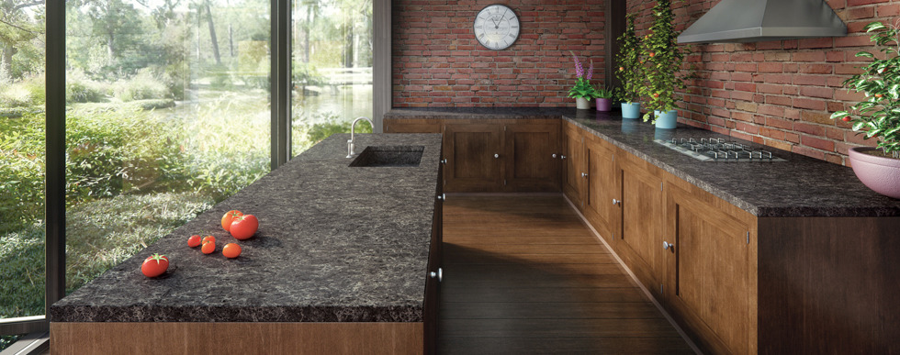It goes without saying that we here at the TD Fall Blog believe the kitchen to be the most popular room in a home (though we’ve said so many times). It is also fairly obvious that we are somewhat skeptical of the trend (fad?) toward sustainability (since human beings tend toward trendy ideas until they get hit in the wallet). Having said these things, however, trends must be recognized and, if possible, capitalized upon. This includes things like sustainable kitchen countertop materials.
A recent article at Houzz.com offers guidance in this category, with 5 Sustainable Kitchen Countertop Materials to Consider. Though largely intended for consumers, author Barbara Milner offers insight into the world of manufacturing countertops with “sustainability and health in mind”.
We’ve chosen to feature two of the more unique types of sustainable countertop manufacturers, with another that we find intriguing.
Sustainable Countertop Manufacturers
A brand that was not mentioned in the article is Caesarstone. Headquartered in Charlotte, NC, the company manufactures premium quartz surfaces, which are used in both residential and commercial projects as countertops, vanities, wall cladding, floors, and other interior surfaces.
“Caesarstone combines beauty with outstanding performance, enabling you to bring your design imagination to life.”
Coastal Grey Sustainable Kitchen Countertop by Caesarstone
As they say at their website, “We are consistently trying to improve. Just meeting current industry standards isn’t enough – we’re always trying to exceed them and push our industry to adopt more sustainable practices and better eco-efficiency.”
Perhaps one of the most innovative options in the sustainable countertop category is Richlite paper-based countertops. The product is made from 65% FSC-certified recycled paper and 35% resin, and can withstand heat up to 350 degrees Fahrenheit. It is fire resistant and durable in high-traffic areas.
Richlite will show scratches and patina over time, much like stainless, wood or copper countertops. However, the scratches can be sanded and the material can be resealed to restore its smooth finish.
Richlite Sustainable Paper Countertops
From their website: “A cost-effective, long-lasting and earth-friendly alternative to natural or manufactured stone, Richlite countertops bring a warm and natural touch to any interior environment.”
IceStone Recycled Glass Kitchen Countertops
Another interesting line of countertops comes from a Brooklyn-based company named IceStone. Manufactured from recycled glass, as well as nontoxic pigments and Portland cement, IceStone offers a terrazzo look and feel. It works well for kitchen countertops, bathroom vanities, desks and fireplace surrounds.
From their website: “IceStone began in 2003 with a simple concept; transform waste glass into something beautiful. Every IceStone slab is made in our 55,000-square-foot repurposed facility in the Brooklyn Navy Yard in Brooklyn, New York that dates back to the early 1900’s.”
Whether you believe sustainable design is a passing fad or a solid, lasting trend, being aware of alternatives makes sense to a sharp designer. Being “in the know” about sustainable kitchen countertop products and designs will keep you ahead of your competition.
Looking for more tips on sustainable design trends, designer marketing tips, and product ideas? Get in touch with TD Fall today.













 Even better, with new home construction (up 8% to 35% for multi-family) and business/commercial building (up some 9% nationwide) on the rebound, the factors that influence and drive growth in the design profession, included competition, costs and profitability, industry economy, pace of change, perceived lack of value, regulation and liability, sustainability, and time factors show no signs of slowing down these current trends in the marketplace.Design Elements that are Spurring Interior Design GrowthWhy is this happening, you may ask. Well, as we’ve discussed in two previous blog posts within the past year, sustainability and technology have become critically important elements in the marketplace, both of which are helping to drive these upward trends. Other elements that are being incorporated into interior design projects, and that are having a powerful influence on growth in the industry, most often include health, innovation, science and tech, and security.For more on how technology and sustainability are driving market trends in interior design, check out these two posts:
Even better, with new home construction (up 8% to 35% for multi-family) and business/commercial building (up some 9% nationwide) on the rebound, the factors that influence and drive growth in the design profession, included competition, costs and profitability, industry economy, pace of change, perceived lack of value, regulation and liability, sustainability, and time factors show no signs of slowing down these current trends in the marketplace.Design Elements that are Spurring Interior Design GrowthWhy is this happening, you may ask. Well, as we’ve discussed in two previous blog posts within the past year, sustainability and technology have become critically important elements in the marketplace, both of which are helping to drive these upward trends. Other elements that are being incorporated into interior design projects, and that are having a powerful influence on growth in the industry, most often include health, innovation, science and tech, and security.For more on how technology and sustainability are driving market trends in interior design, check out these two posts: As mentioned in a previous post, Know Your Marketplace - Millennials Influencing Interior Design Trends, the influence of millennials is growing, in many ways shifting the focus and goals of the interior design industry. Of the many ways in which this demographic is influencing our market, sustainability may be the most important – and enduring – as it become ever more important to other age groups and market influencers.As explained by the
As mentioned in a previous post, Know Your Marketplace - Millennials Influencing Interior Design Trends, the influence of millennials is growing, in many ways shifting the focus and goals of the interior design industry. Of the many ways in which this demographic is influencing our market, sustainability may be the most important – and enduring – as it become ever more important to other age groups and market influencers.As explained by the